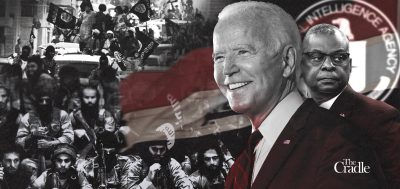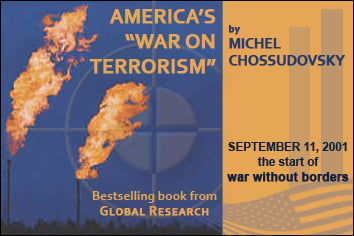Reviving ISIS: A US Sponsored “Proxy Weapon” Against the “Resistance Axis”
Is it a coincidence that the world's foremost terror organization is being revived just as the US struggles under a multi-front assault on its hegemony in West Asia? More curiously, both ISIS and Washington's targets are exactly the same.

All Global Research articles can be read in 51 languages by activating the Translate Website button below the author’s name (only available in desktop version).
To receive Global Research’s Daily Newsletter (selected articles), click here.
Click the share button above to email/forward this article to your friends and colleagues. Follow us on Instagram and Twitter and subscribe to our Telegram Channel. Feel free to repost and share widely Global Research articles.
New Year Donation Drive: Global Research Is Committed to the “Unspoken Truth”
***
Iraqi security sources are warning of an ISIS revival in the country, which coincides all too neatly with the spike in Iraqi resistance operations against US bases in Iraq and Syria, and with widening regional instability caused by Israel’s military assault on Gaza.
More than six years after declaring victory over the terrorist organization, Iraqi intelligence reports now indicate that thousands of ISIS fighters are emerging unscathed, under the protection of US forces in two regions of western Iraq.
The Missing Piece of the Puzzle
According to intelligence reports reviewed by The Cradle, at its height, ISIS consisted of more than 35,000 fighters in Iraq – 25,000 of these were killed, while more than 10,000 simply “disappeared.”
As an officer of one Iraqi intelligence agency recounts to The Cradle:
“Hundreds of ISIS fighters fled to Turkey and Syria at the end of 2017. After the appointment of Abdullah Qardash as the leader of ISIS in 2019, following the death of Caliph Abu Bakr al-Baghdadi, the new Caliph began to restructure the organization, and ordered his followers to return to Iraq. The organization exploited the long border with Syria, the security disturbances, and the diversity of forces on both sides of the border to infiltrate the Iraqi territory again.”
Imprisoned ISIS officials admit that infiltrating that border is not an easy task, because of the strict control imposed by the Iraqi Border Guards and the use of modern technologies, such as thermal cameras.
It therefore became necessary for the terror group to identify intermediaries capable of breaking through or bypassing these fortifications to transport its fighters across borders.
An Iraqi security source, insisting on anonymity, tells The Cradle that the US plays a vital role in enabling these border violations:
“[There are] several incidents that confirm the American assistance in securing the crossing route for ISIS members – mainly, by shelling Iraqi units on the border, especially the Popular Mobilization Units (PMUs), to create gaps that allow ISIS fighters to cross the border.”
The Iraqi security source adds that there are confirmed reports of US Chinook helicopters transporting fighters from eastern Syria to the Anbar desert in western Iraq and Jebel Hamreen, in the country’s east.
Munir Adib, a researcher specializing in Islamist movements, extremist organizations, and international terrorism, confirms the possibility of the return of ISIS after the organization’s “dozens of attacks in Syria and Iraq in the past few weeks,” which led to the death of tens of civilians and soldiers.
According to Adib, “the international community’s preoccupation with the Gaza and Russia-Ukraine wars gave ISIS an opportunity to reorganize its ranks, while continuing to receive internal and external logistical support.”
Manufacturing and Harboring Terrorism
Houran Valley is the largest of its kind in Iraq, extending 369 kilometers from the Iraqi-Saudi border to the Euphrates River near the city of Haditha in Anbar Governorate. Its topography is marked by soaring cliffs ranging in height between 150 to 200 meters, and includes the hills surrounding the valley and the sub-valleys that extend into its surroundings.
The valley was and still is one of the most dangerous security environments in the state. Terrorist groups use it as a safe haven because of its desert terrain, and distance from congested urban areas. The valley and its environs have witnessed numerous security incidents, most notably in December 2013, when ISIS killed the commander of the Iraqi army’s Seventh Division, his assistant, the director of intelligence in Anbar Governorate, eight officers, and thirteen soldiers.
Iraqi MP Hassan Salem has called for launching a military operation to clear Houran Valley of terrorist fighters. He confirmed to The Cradle that “there are thousands of ISIS members in the valley receiving training in private camps, under American protection,” noting that US forces have “transferred to this area hundreds of ISIS members of different nationalities.”
US foreign policy, of course, is rife with historical evidence of the creation of proxy armed militias in West Asia and Latin America, often utilizing these organizations to overthrow governments in target countries. We know Washington has no aversion to allying with Islamist extremists largely because of its direct involvement with arming and financing the Afghan Mujahideen, from which the Taliban and Al Qaeda emerged.
An early US-ISIS connection exists quite clearly: the terrorist group’s founding and second rank leaders were among the inmates of Camp Bucca prison in southern Iraq, an internment facility run by the US military. The roster of high-value terrorists captured, then set free by the Americans is quite extraordinary: ISIS leader Abu Bakr al-Baghdadi, his successor Abu Ibrahim al-Hashimi al-Qurashi, Abu Mohammed al-Adnani, Abu Muslim al-Turkmani, Haji Bakr, Abu Abdulrahman al-Bilawi, Abu Ayman al-Iraqi, among others.
Camp Bucca, known for abuses against its detainees, brought together extremist elements, slow-boiled this combustive formula for six years (2003-2009), then let the now well-networked extremists go free.
The religious officials of ISIS even say they used their time at the prison to obtain vows from prisoners to join the terrorist group after their release.
US intelligence also protected the terrorist organization indirectly, by allowing ISIS convoys to move between the cities that were under its control. Other forms of protection, according to Iraqi security experts, include refusing to implement death sentences issued by Iraqi courts against detained ISIS members, and establishing safe havens for the organization’s members in western and eastern Iraq.
ISIS: US Foot Soldiers in the Regional War
In a speech on 5 January, Hezbollah Secretary General Hassan Nasrallah warned that the US was supporting an ISIS revival in the region.
The Cradle obtained security information monitoring the new activity of extremists in Lebanon, communications between these elements and their counterparts in Iraq and Syria, and suspicious money transfer activities among them.
Lebanese Army Intelligence also recently arrested a group of Lebanese and Syrians who were preparing to carry out security operations.
Importantly, this surge in terror activities comes at a time when the Lebanese resistance is engaged in a security and military battle with Israel, which may expand at any moment into open war. It is also notable that renewed ISIS activity is concentrated in Lebanon, Syria, Iraq, and Iran; that is, in the countries that support the Palestinian resistance politically, militarily, and logistically.
On 4 January, ISIS officially claimed responsibility for two bombings in the Iranian city of Kerman that targeted memorial processions on the anniversary of the assassination of Quds Force Commander Qassem Soleimani by US forces. The dual explosions killed around 90 people and injured dozens, in an unprecedented attack targeting the biggest US-Israeli adversary in West Asia – just one day after Tel Aviv killed top Hamas leader Saleh al-Arouri in Beirut.
Before that, on 5 October 2023, ISIS drone-attacked an officers graduation ceremony at the Military College in the Syrian city of Homs, killing about 100 people. These attacks, and others in Iraq, Syria, Iran, Pakistan, Afghanistan, and Africa, indicate that fresh blood, money, and weapons are being pumped into the ISIS organization’s arteries again.
A high-ranking PMU officer, who asked to remain unnamed, tells The Cradle that US forces are preventing Iraqi forces from approaching Houran Valley by attacking any security forces approaching the area. “This happened when American aircraft targeted units of the PMU that were attacking ISIS in the region,” he reveals, citing intelligence reports confirming the presence of dozens of ISIS members and other extremist organizations in the valley, where they receive training and equipment from US forces.
Security sources in the Anbar Operations Command confirm this information:
“Noticeable activity by the organization had been recorded a few weeks ago in the west of the country. Near the Rutba desert, ISIS fighters were spotted digging underground hideouts. Information indicates that the organization is in the process of carrying out terrorist operations in many locations,” they tell The Cradle.
Concurrently, ISIS is expanding its operations in the east of Iraq, within the geographical triangle that includes eastern Salah al-Din Governorate, north-eastern Diyala, and southern Kirkuk, particularly in the geographically challenging Makhoul, Hamrin, Ghurra, Wadi al-Shay, and Zaghitoun areas.
It should be noted that US forces are deployed in Iraq under the umbrella of the International Coalition to Combat ISIS. Last week, four years after the Iraqi parliament first voted to expel foreign forces, Iraqi Prime Minister Mohammad Shia al-Sudani weighed in on the “destabilizing” impact of US troops and demanded a “quick and orderly” exit of those combat units.
Washington not only countered by saying it has “no plans” to withdraw from Iraq, but announced on 14 January that it would be sending an additional 1,500 troops to Iraq and Syria illegally, and without the consent of either nation.
One irony here is that ISIS appears to regain momentum each and every time Baghdad raises the issue of US military withdrawal from Iraq.
It can also no longer be seen as a coincidence that the terror group is now re-assembling its forces to target Washington and Tel Aviv’s most capable regional foes – the Axis of Resistance – just when the US and Israel are struggling to handle a region-wide, multi-front assault from the Axis.
The extraordinary synergies between the Americans and the world’s foremost terror group can no longer be ignored: their targets are one and the same, and ISIS is only now entering the fray, just as Washington begins to lose its hold on West Asia.
*
Note to readers: Please click the share button above. Follow us on Instagram and Twitter and subscribe to our Telegram Channel. Feel free to repost and share widely Global Research articles.
Featured image is from The Cradle
In this new and expanded edition of Michel Chossudovsky’s 2002 best seller, the author blows away the smokescreen put up by the mainstream media, that 9/11 was an attack on America by “Islamic terrorists”. Through meticulous research, the author uncovers a military-intelligence ploy behind the September 11 attacks, and the cover-up and complicity of key members of the Bush Administration.
The expanded edition, which includes twelve new chapters focuses on the use of 9/11 as a pretext for the invasion and illegal occupation of Iraq, the militarisation of justice and law enforcement and the repeal of democracy.
According to Chossudovsky, the “war on terrorism” is a complete fabrication based on the illusion that one man, Osama bin Laden, outwitted the $40 billion-a-year American intelligence apparatus. The “war on terrorism” is a war of conquest. Globalisation is the final march to the “New World Order”, dominated by Wall Street and the U.S. military-industrial complex.
September 11, 2001 provides a justification for waging a war without borders. Washington’s agenda consists in extending the frontiers of the American Empire to facilitate complete U.S. corporate control, while installing within America the institutions of the Homeland Security State.


